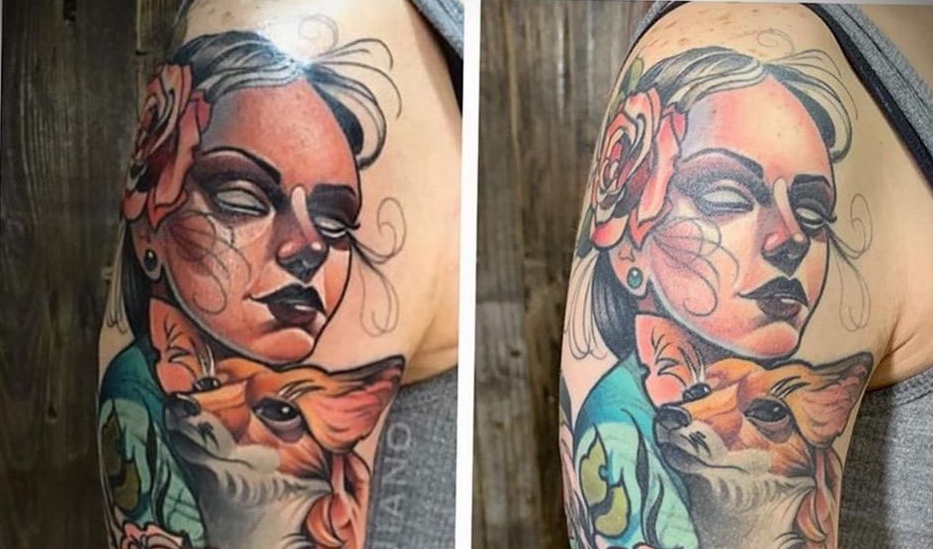

Straight after your tattoo session, it will look very bright and colorful. After a few days, these effects may start to fade a bit as your skin has started to get used to the ink. It will still look great as long as you take care of it and let it heal properly.
Your tattoo will naturally fade over time. For some people, it may only take a few years for them to start noticing that the ink doesn’t look as strong as it used to. For others, the paleness of the tattoo may not be noticeable for decades.
If you plan to get a tattoo when you are young, maybe in your 20s to 30s, you might not notice the fading of your tattoo until you reach your 50s! Good care and maintenance of your ink can help slow down this process quite significantly, but we’re not going to lie and say that your tattoo will never fade. It’s completely natural and normal to see tattoo fade over time. As for how quickly tattoos fade, there are some factors that can make it worse for some people.

Now that we are familiar with some of the main causes of tattoos aging, we all want to know how to keep our tattoos from fading. Below are some suggestions some kind of things you can implement in your daily routine to prevent your tattoos from fading quickly.
1. Take Care of Your Tattoo When It’s Newly Made
A well-healed tattoo is the easiest to maintain. The tattoo healing process involves several stages; it requires dedication and patience. However, if the tattoos are not properly cared for and healed, they are likely to change and fade faster. Taking care of the tattoo right from the start will ensure healthy habits and longevity.
Part of this immediate care is refraining from scratching or picking at the peeling skin. Yes, this can be a difficult task, especially in hot or humid conditions when itchiness and discomfort are at their peak, but remember that scratching and picking at peeling skin is part of our body’s natural healing process.
Interfering with it can lead to a variety of problems, including distorted image and color, slower healing, scars and in the worst cases, tattoo infection.
2. Consider the Location of the Tattoo
When choosing the perfect tattoo location, consider the areas of your body that experience the least amount of friction. For example, tattoos on parts of the body like the palms and feet will likely experience more friction than tattoos on the back of your neck.
Shoes and socks can potentially cause fading over time as your feet are probably always in contact with something. Remember back to the part about irritation and how it can lead to faster tattoo fading.
3. Wear Protective Clothing and Sunscreen Products When Outside
Protecting your skin from direct sunlight is essential for its health and beauty. However, we want to emphasize that the sun really does damage your tattoo at all stages of its life, from the healing stage to 30 years later.
Wearing sunscreen at the very least, if you can cover it with loose clothing or some sort of covering, would be ideal. That can be a big challenge, so do your best to always apply sunscreen frequently! A tattoo-friendly daily mineral sunscreen, made from clean ingredients, can really add years to the life of your tattoo colors.
4. Avoid Smoking (or Even Better, Don’t Do It At All)
Smoking is bad for you. This is not news. But smoking can also make your tattoos look faded and dull! Smoking reduces collagen production in the body – which makes the skin more elastic. If your skin’s elasticity is reduced, your ink has a high chance of bleeding out.
Just as smoking fouls the fingers of regular smokers, it can cause discoloration and yellowing of existing works.
When smoke enters your body, it constricts blood vessels and reduces blood flow. This can slow down the healing process, increase the risk of infection and contribute to scar formation.

5. Moisturize Your Skin Regularly
Hydrated skin has a better chance of staying healthy and less irritated. When your skin is well-hydrated (and happy), it will look much fresher and less dry and chapped. Using unscented and organic ointments and lotions helps to ensure you’re not using chemicals that can actually dry out the skin.
From fresh ink to older tattoos and general skincare, moisturization is key at every stage. Moisturize your skin with quality natural ingredients for the best effect while limiting the use of petroleum-based products that can form a waxy film.
6. Keep Moisture & Health
Skin health can be affected by many things – which can affect the appearance of your tattoo as time goes on. Drinking water every day is a great first step for skin health.
On top of that, drinking water is also great for overall health. Exercising and maintaining a balanced diet may sound simple, but it really does make a difference in keeping your skin looking and feeling good!
7. Choose a Professional Tattoo Artist
Becoming an expert in the tattoo industry requires more than just being a great illustrator and owning a tattoo machine. Having the most recognizable name in the tattoo field can take much longer than that.
A true professional tattoo artist has the creativity necessary to create beautiful works of art and an understanding of how to properly apply the tattoo to the skin to reduce trauma and make it last for years.
Remember, tattoos are meant to last a lifetime, so spending the extra time, weeks or months researching a trustworthy artist will pay off in the long run. Social media and recommendations from friends or even passing strangers whose work looks good are great resources to help you in this process.
8. Renewing Tattoos as They Age
As we have already explained, some conditions such as tattoos looking pale, distorted and blurred are inevitable in the tattoo aging process. A touch of renewal can bring back some of the joy of when your tattoo was first created. It’s important to note that not all artists will feel comfortable making updates to another artist’s tattoo artwork, so keep in touch with artists who have been creating your tattoos for years – they’ll most likely be happy to see how their artwork has aged and will improve it to your liking.